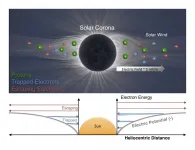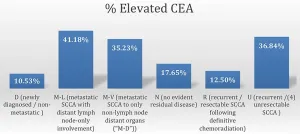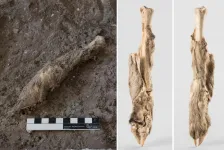(Press-News.org) As the Parker Solar Probe ventures closer to the sun, we are learning new things about our home star.
In a new study, physicists led by the University of Iowa report the first definitive measurements of the sun's electric field, and how the electric field interacts with the solar wind, the fast-flowing current of charged particles that can affect activities on Earth, from satellites to telecommunications.
The physicists calculated the distribution of electrons within the sun's electric field, a feat made possible by the fact that the Parker Solar Probe jetted within 0.1 astronomical units (AU), or a mere 9 million miles, from the sun--closer than any spacecraft has approached. From the electrons' distribution, the physicists were able to discern the size, breadth, and scope of the sun's electric field more clearly than had been done before.
"The key point I would make is you can't make these measurements far away from the sun. You can only make them when you get close," says Jasper Halekas, associate professor in the Department of Physics and Astronomy at Iowa and the study's corresponding author. "It's like trying to understand a waterfall by looking at the river a mile downstream. The measurements we made at 0.1 AU, we're actually in the waterfall. The solar wind is still accelerating at that point. It's really just an awesome environment to be in."
The sun's electric field arises from the interaction of protons and electrons generated when hydrogen atoms are stripped apart in the intense heat generated by fusion deep within the sun. In this environment, electrons, with masses 1,800 times less than that of protons, are blown outward, less constrained by gravity than their weightier proton siblings. But the protons, with their positive charge, exert some control, reining in some electrons due to the familiar attraction forces of oppositely charged particles.
"Electrons are trying to escape, but protons are trying to pull them back. And that is the electric field," says Halekas, a co-investigator for the Solar Wind Electrons, Alphas, and Protons instrument aboard the Parker Solar Probe, the NASA-led mission that launched in August 2018. "If there were no electric field, all the electrons would rush away and be gone. But the electric field keeps it all together as one homogenous flow."
Now, imagine the sun's electric field as an immense bowl and the electrons as marbles rolling up the sides at differing speeds. Some of the electrons, or marbles in this metaphor, are zippy enough to cross over the lip of the bowl, while others don't accelerate enough and eventually roll back toward the bowl's base.
"We are measuring the ones that come back and not the ones that don't come back," Halekas says. "There's basically a boundary in energy there between the ones that escape the bowl and the ones that don't, which can be measured. Since we're close enough to the sun, we can make accurate measurements of electrons' distribution before collisions occur further out that distort the boundary and obscure the imprint of the electric field."
From those measurements the physicists can learn more about the solar wind, the million-mile-per-hour jet of plasma from the sun that washes over the Earth and other planets in the solar system. What they found is the sun's electric field exerts some influence over the solar wind, but less than had been thought.
"We can now put a number on how much of the acceleration is provided by the sun's electric field," Halekas says. "It looks like it's a small part of the total. It's not the main thing that gives the solar wind its kick. That then points to other mechanisms that might be giving the solar wind most of its kick."
The paper, "The sunward electron deficit: A telltale sign of the sun's electric potential," was published online July 14 in The Astrophysical Journal.
INFORMATION:
Contributing authors include Laura Bercic, from University College London; Phyllis Whittlesey, Davin Larson, Marc Pulupa, and Stuart Bale, from the University of California, Berkeley; Matthieu Berthomier, from the University of Paris-Saclay; Justin Kasper, of the University of Michigan and the Smithsonian Astrophysical Observatory; Anthony Case and Michael Stevens, of the Smithsonian Astrophysical Observatory; and Robert MacDowall, of NASA Goddard Space Flight Center.
NASA funded the research.
For the first time, scientists have seen stony coral cells engulf dinoflagellates - single-celled, photosynthetic algae that are crucial for keeping coral alive
The researchers used a cell line called IVB5, which contains endoderm-like cells cultured from the stony coral, Acropora tenuis
Around 40% of coral cells incorporated the algae in around 30 minutes and remained healthy for one month
The research is a step towards understanding the partnership between coral and dinoflagellates and could shed light on how coral bleaching occurs
In a world-first, scientists in Japan have observed individual stony coral cells engulfing single-celled, photosynthetic algae.
The microscopic algae, known as dinoflagellates, were ...
A new paper in the Journal of the National Cancer Institute, published by Oxford University Press, indicates that disruptions in health care due to the COVID 19 pandemic may increase breast cancer deaths.
In March 2020 public health measures prohibited most elective procedures, including mammography, due to hospital capacity and limited personal protective equipment. This reduced mammograms up to 80%. Breast cancer patients also experienced treatment delays and reductions in planned or expected chemotherapy treatments.
Researchers here used three independently-developed breast cancer simulation models from the National Cancer Institute's Cancer Intervention and Surveillance Modeling Network to ...
Washington/Philadelphia, July 14, 2021--New research finds that high school students who attended school remotely during the COVID-19 pandemic suffered socially, emotionally, and academically compared with those who attended in person.
The study was published today in Educational Researcher (ER) by researchers Angela L. Duckworth, Tim Kautz, Amy Defnet, Emma Satlof-Bedrick, Sean Talamas, Benjamin Lira, and Laurence Steinberg. ER is a peer-reviewed journal of the American Educational Research Association.
"Many news stories have reported on individual stories of teenagers who have suffered from anxiety, depression, and other mental health challenges during the pandemic," said lead author Duckworth, ...
Oncotarget published "CEA as a blood-based biomarker in anal cancer" which reported that the mean Carcinoembryonic Antigen (CEA) among subgroups by clinical status at the time of presentation to our institution was highest among those patients with metastatic Squamous cell carcinoma of the anal canal (SCCA) to visceral organs, however this finding was not statistically significant by ANOVA .
By clinical subgroup, the percentage of patients with an abnormally elevated CEA was highest in those patients with metastatic disease to lymph nodes followed by recurrent/unresectable SCCA , and metastatic SCCA ...
New research published online in the International Journal of Mental Health and Addiction found that Canadians with a history of drug dependence are much less likely to have flourishing mental health and are more likely to have mental illness.
Researchers compared a nationally representative sample of 460 Canadians with a history of illicit drug dependence (excluding cannabis) to 20,305 Canadians with no history of illicit drug dependence using data drawn from Statistic Canada's Canadian Community Health Survey-Mental Health.
While 80% of those with a history of drug dependence were in remission, more than half (52.1%) were still experiencing mental illness. Further, only 37.9% were in excellent mental health, which is markedly lower than the 74.1% of ...
Unlike other population-level stressful events such as natural disasters, COVID-19 has not resulted in a net increase in smoking, according to a new study from the International Tobacco Control (ITC) Project, at the University of Waterloo.
The researchers also found that although nearly half of smokers reported that COVID-19 made them think about quitting, the vast majority of smokers did not change their smoking habits during the early phase of the COVID-19 pandemic.
Led by Shannon Gravely, research assistant professor with the ITC Project, the study ...
Before Millennials were over laugh-cry emojis, they were the most used emojis across the world, according to researchers at USC. The emoji was more popular than smiley faces say researchers who categorized millions of tweets across 30 countries and evaluated over 1700 emojis. Their study, "An empirical study of emoji usage on Twitter in linguistic and national contexts" was published in Online Social Networks and Media.
Mayank Kejriwal, a research assistant professor in the Department of Industrial and Systems Engineering, and a research lead at the USC Information Sciences Institute who is the lead author on the paper, says approximately 100 emojis are used most often.
The most important take away? Emojis represent ...
A new study by researchers at Queen Mary University of London, University of Oxford, Institute for Advanced Studies, Vienna, and the Medical University of Graz, has found that lateral flow tests detect Covid-19 with similar accuracy to laboratory-based PCR tests, providing they are used at the onset of infection and soon after symptoms start.
Lateral flow tests are cheaper and produce a result in just 30 minutes - much faster than the time it takes to receive a PCR test result, which can take 1-3 days. The finding could be pivotal to national strategies ...
A team of geneticists and archaeologists from Ireland, France, Iran, Germany, and Austria has sequenced the DNA from a 1,600-year-old sheep mummy from an ancient Iranian salt mine, Chehrābād. This remarkable specimen has revealed sheep husbandry practices of the ancient Near East, as well as underlining how natural mummification can affect DNA degradation.
The incredible findings have just been published in the international, peer-reviewed journal Biology Letters.
The salt mine of Chehrābād is known to preserve biological material. Indeed, it is in this mine that human remains of the famed "Salt Men" were recovered, dessicated by the salt-rich environment. The ...
Survival for a baby born with a birth defect - otherwise known as a congenital anomaly - is a "post-code lottery", according to scientists from 74 countries.
A study published today in The Lancet, led by researchers from King's College London, examined the risk of mortality for nearly 4000 babies born with birth defects in 264 hospitals around the world. The study found babies born with birth defects involving the intestinal tract have a two in five chance of dying in a low-income country compared to one in five in a middle-income country and one in twenty in a high-income country.
Gastroschisis, a birth defect where the baby is born with ...


